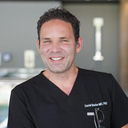I assume you are talking about the inverted 'V' shaped incision on the columella which is used for approach in open rhinoplasty technique. If that is correct, you don't have to do much. Those incisions heal very well. However, an infection or suboptimal closure of the wound can lead to scarring. If you see signs of any infection, such as redness, yellow drainage, pain on touching or fever, report to your physician immediately. In terms of good closure, you should be able to tell right away if the skin incision is level or not.






